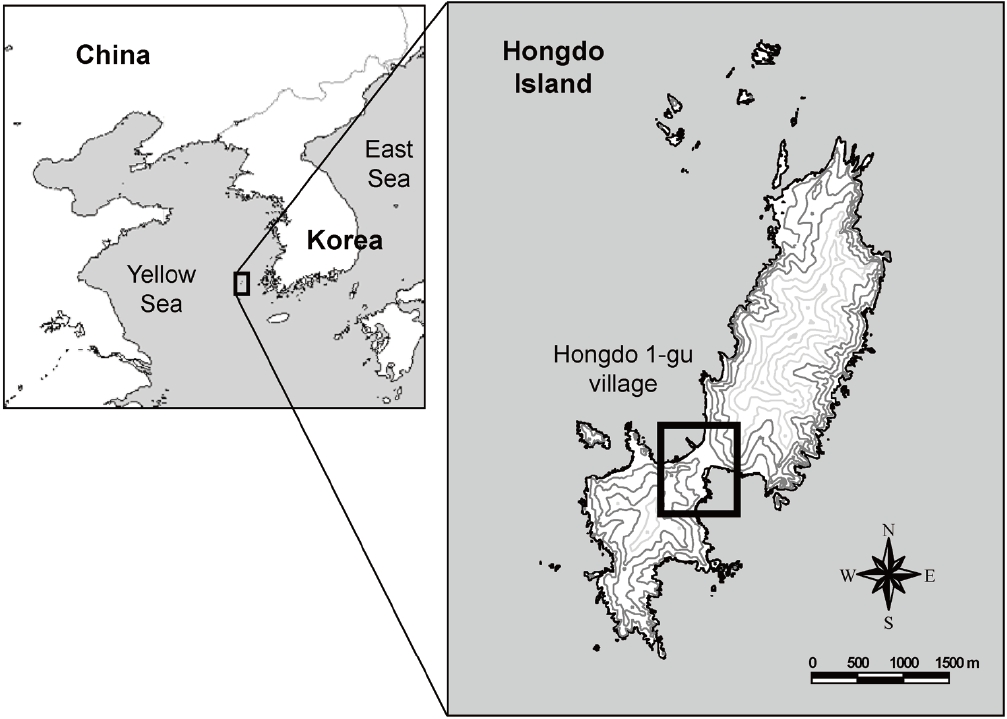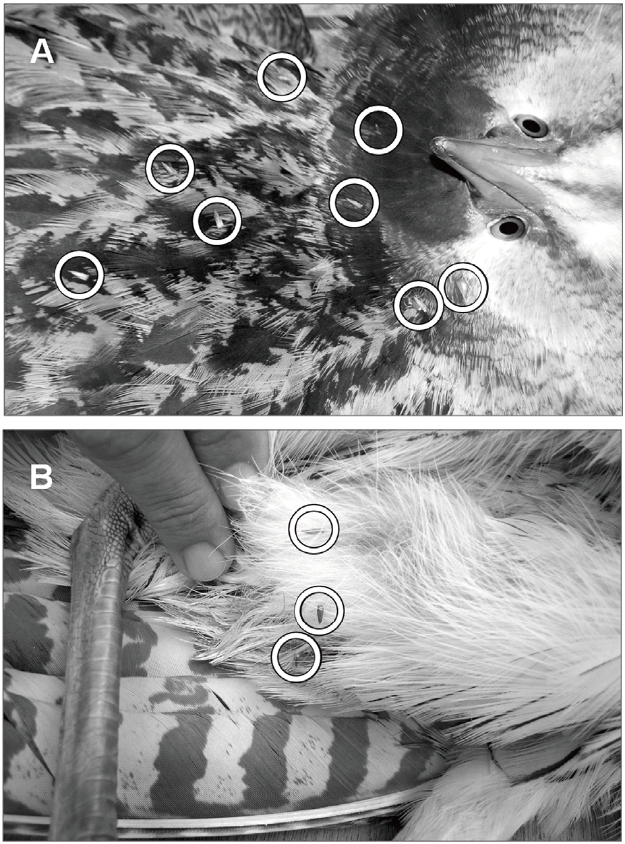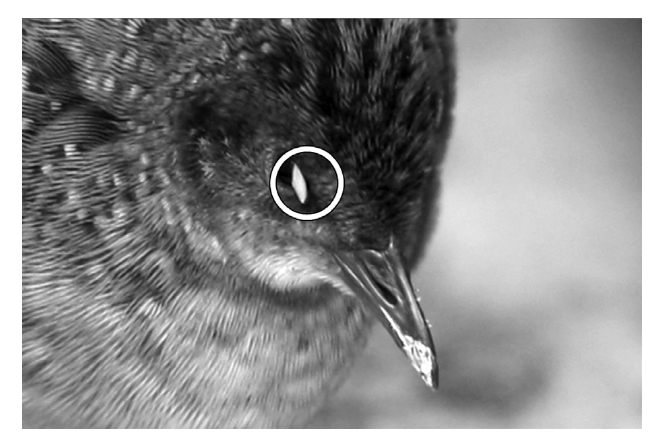



Migratory birds, by crossing significant ecological barriers, carry and may subsequently introduce exotic seeds into new ecological zones during period of migration. The study of epizoochory, which includes seed dispersal by adhesion to bird feathers, has been relatively neglected compared to the study of seed dispersal by frugivores. To determine whether exotic seeds are being imported to stopover islands by migrating birds, and to estimate the quantity of seeds of exotic species being introduced, we examined migratory birds that were captured in mist nets for attached exotic plant diaspores in 2008 and 2009 on Hongdo Island, Korea. From a total of 3,947 birds examined, we found exotic seeds of Japanese Chaff Flowers (Achyranthes japonica) attached to three species of migratory birds (0.08%; Eurasian Bittern Botaurus stellaris, Swinhoe’s Rail Coturnicops exquisitus and Oriental Turtle Dove Streptopelia orientalis). Despite the low occurrence of A. japonica seeds on the external parts of birds, the results suggest that migratory birds may be potential dispersing agents for A. japonica, a species that is currently threatening native ecosystems on many islands in Korea.
Seed dispersal is the process of departure of seeds away from the parent plant (Howe and Smallwood 1982). Because plants have relatively limited mobility, external agents are often involved in the transport of plant fruits and seeds. Although some plants with explosive fruits or creeping diasporas have the ability to self-disperse their seeds, the major dispersal agents for most plant species are water, wind, and animals (Howe and Smallwood 1982). Among these agents, animals can disperse seeds in a variety of ways. For example, seeds can be dispersed by scatter-hoarding birds, mammals, and ants (Sorensen 1986). Moreover, endozoochory or the dispersal of seeds through the digestive tract of frugivores, that consume fruits and swallow seeds, isa common and welldocumented mutualistic interaction between animals and plants subsequently dispersing seeds (Howe and Smallwood 1982, Sorensen 1986, Jordano 1995, Fukui 2003). However, seed dispersal by adhesion on animal fur and feathers, known as epizoochory, is also a distinctive dispersal mechanism, because epizoochorus fruits or seeds do not provide the dispersing agent with a nutritional or energetic reward (Sorensen 1986).
Many researchers have focused on the ecological functions of endozoochory and the nature of mutualistic interactions between animal dispersers and plants (e.g., Jordano 1995, Fukui 2003), while epizoochory has only been investigated to a limited extent (Sorensen 1986). However, epizoochorus seed dispersal seems to be the more important mechanism on islands because seeds dispersed by external adhesion have the potential for longer distance dispersal than do frugivores or winddispersed seeds (Vivian-Smith and Stiles 1994). At present, most evidence for epizoochorus seed dispersal is anecdotal or is concentrated on terrestrial mammals; only a few quantitative studies have focused on avian dispersers (Sorenson 1986, Vivian-Smith and Stiles 1994). In Korea, several studies have reported seed dispersal following passage through bird digestive systems (You et al. 1994, Choi and Chae 2007); however, to our knowledge there have been no reports of adhesive seed dispersal by birds.
Rose and Polis (2000) suggested five major types of interactions involving migratory and transient species on islands: predation, parasite and pathogen transmission, competition, zoogeomorphology, and cascading events. Among the migratory animal taxa, birds may act as particularly efficient dispersers of exotic seeds by traveling long distances and crossing significant ecological barriers such as seas and deserts. Therefore, avian migrants are thought to be responsible for the introductions of many exotic plants and may initiate cascading events on isolated islands by dispersing seeds (Vivian-Smith and Stiles 1994, Rose and Polis 2000).
In this study, we examined patterns of seed adhesion on the external parts of migrating birds that stopover on Hongdo Island to determine whether exotic seeds are being imported to stopover islands in Korea by adhesion to birds and to estimate the quantity of exotic seed being imported to these islands by migratory birds.
We conducted surveillance for epizoochorus diasporas at Hongdo 1-gu on Hongdo Island, Shinan-gun, Jeonnam Province, Republic of Korea. Hongdo Island (N 34℃ 41’, E 125℃ 11’) is located 115 km from the southwestern part of the Korean Peninsula (Fig. 1). The island is an important stopover site for migratory birds during their migratory crossing of the Yellow Sea between Korea and China.
>
Epizoochorus Diaspore Surveillance
In 2008 and 2009, we set three mist nets (2.5 m × 12 m; mesh sizes: 32 and 38 mm) daily from 07:00 to 18:00 to capture migratory birds on Hongdo Island. Birds trapped from March to December were ringed, measured, and then released following the banding scheme of the Korean National Park Migratory Birds Center (NPMBC). We examined all birds captured for plant seeds on their external parts before their release, and collected samples of the seeds for subsequent species- level identification.
We trapped and examined a total of 3,947 birds from 117 species on Hongdo Island from March to December in 2008 and 2009. In 2008, plant diaspores were found attached to only two of 1,777 birds examined: one Eurasian Bittern (
The Japanese Chaff Flower (
Our evaluation of epizoochory by birds on a migratory stopover island, confirmed that autumn migrating birds can bear seeds of the exotic plant,
Seeds of
We conclude that migratory birds can bear, and may act as dispersers of seeds of exotic plants to stopover islands in Korea. Our study confirmed that feathers of three migrating non-passerines bore seeds of the exotic plant,



